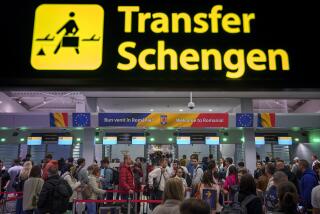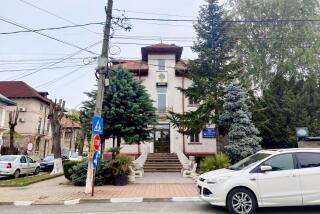Roaming Back Roads of Romania by Rental Car
- Share via
BUCHAREST, Romania — When a friend and I booked our 10-day Romania self-drive package it seemed too good to be true: rental car with unlimited mileage, insurance, even coupons for 70 liters of gas, hotels, two meals a day, visa, transfers and assistance on arrival and departure. All for just over $600 each.
On schedule, we were delivered to the rental-car office. After buying additional gas coupons at 85 cents a liter (unused coupons can be redeemed for dollars at the airport), we loaded baggage and ourselves into a gray Olt-Seit and started off.
Of course we got lost leaving Bucharest, the capital. Fluency in French would have helped, but then it might have taken another hour or so to learn how ready Romanians are to lend a hand, particularly to Americans. “We’re compatible temperamentally,” we were to hear over and over. “After all, Romanians are Latins!”
About 20 minutes later our confidence level suffered a second set-back when we were pulled over for speeding in a check-point zone. These troublesome police control areas, where 40 k.p.h. is the rule, pop up every so often.
For a while we thought the communication gap might win the day, but law prevailed and we drove off $12 poorer. Still, we had our first souvenirs, two 50-lei receipts.
Romanian Status Symbol
A lunch stop at Sinaia, a charming Carpathian Mountains ski and hiking center, broke up the 105-mile drive to Brasov. Both waiter and parking-lot attendant made tempting bids for Kents (Romanians’ obsession with this status symbol must be seen to be believed). However, single “gift” cigarettes produced fast service and free parking.
Our main goal at Brasov was nearby Bran Castle 398 of Dracula fame. Although past closing time, the caretaker let us squeeze through the gate, then slammed it shut on the Romanian family behind us. Eventually he relented and we roamed together over the grounds, the grandmother stopping every few yards to bestow a gold-toothed grin and kiss.
Other Brasov memories include weighted glasses complete with attached glass coasters, a sign warning us to use the hotel safe “in order to keep your values” and too much wine at the Cerbul Carpatin folkloric theater-restaurant where revelers at the next table made certain our glasses were never empty.
Next morning we set off for Sibiu, about 90 miles west. After a stop in Fagaras to see its restored 13th-Century citadel we detoured to the village of Simbala de Sus. By sheer luck, villagers were just leaving the chapel. After happily posing for photos, the traditionally clad women thrust more than a dozen rolls, blessed by the priest only minutes before, into our hands.
Our goal was Simbala a few miles further on, as the icons in its monastery are highly touted by Fodor. Mass had just ended and the priests, after blessing their car, hopped in and drove away. We found no one to ask about icons and little of interest in the buildings, which are undergoing extensive restoration.
‘Eyebrow’ Windows
Sibiu offered “eyebrow” windows (narrow rectangular slits with gable overhangs), overcrowded beer gardens and a teen-ager who insisted on reciting his repertoire of U.S. trivia: L.A. has smog, Hollywood’s 20 minutes away, there’s a bubble gum factory in East Hanover, N.J. (I’ve no idea if this is true), the East River is in New York City and the Corn Belt in the Midwest.
Adding that his country is “bad for the nervous system” and he’s “too young for a nervous condition,” he hit us for T-shirts and sneakers, incredulous that two Americans would be traveling without an abundant supply.
After climbing 11 flights of stairs (the hotel elevators weren’t working), we devoured a couple of bottles of Apa, the marvelous, inexpensive mineral water available everywhere, and decided to call it a day.
The drive to Baia Mare, 200 miles northwest, took eight hours. The roads were fine. It was all the photo stops for haystacks gleaming against emerald fields; stork nests atop utility poles; a teen-age hoe brigade off to help with the harvest; V-shaped horse carts; colorful houses, often tiled or muraled; towering wooden gates, each uniquely carved; front-yard wells, some resembling Thai spirit houses, others with long weighted poles like Egyptian shadoofs; roadside crucifixes decorated with birds, flowers or geometrics.
Yankee Ingenuity at Work
For all its beauty and tradition, the Maramures region gets few Western tourists. Even hotel waiters spoke no English, so we moooed, clucked and baaa-ed, extending the limits of American ingenuity. The majority of menu items usually aren’t available anyway, so a big vocabulary isn’t vital.
Assuming you can keep eyes straight ahead and ignore the scenery, it’s a short drive north to Sapinta, home of the “Happy Cemetery.” Vivid paintings, folk art style, depict the deceased’s life: housewives weave, cart wool, or stand by whitewashed stoves, while men ply their trades as vets, barbers, soldiers, musicians.
Leaving Sapinta, we headed east toward Borsa. Old women sat by the road, coaxing strands of coarse wool from long staffs onto spindles. Woven panels of red and black stripes covered their full skirts. Shoes typical of the region resembled ballet slippers with open backs, peaked toes and laces criss-crossing up thick red socks to mid-calf.
Our Borsa hotel was packed. While we sat on the terrace enjoying the mountain scenery, Eastern European tourists sunbathed on the grounds and congregated in the smoke-filled bar.
Soon a young man approached. His girlfriend clearly coveted my earrings, but he was more interested in gas coupons and dollars. Realizing our acquisitive bent ran toward folk craft rather than leis, he returned shortly with an embroidered wedding skirt, two beribboned Maramures straw hats and a pair of pointy shoes.
Luggage a little heavier, we set off next morning over Prislop Pass to Moldavia. There in the 15th and 16th centuries numerous monasteries were built whose exterior walls were designed as visual Bible lessons for the illiterate masses. Frescoes, many still remarkably vivid, cover every square inch of these huge “picture books.”
Special Memories
Although more than a dozen such churches remain, Moldovita, Sucevita, Arbore, Humor and Veronet are the five usually visited. you can reach all easily from Suceava, touristic center of the region. It would be possible, but exhausting, to do the circuit in one day.
Each church left that special memory: two nuns at Moldovita, smiling beneath their high black hats as they paused from selling crosses and cards to pose for our cameras; devils waiting for climbers to fall off Jacob’s ladder in Sucevita’s largest fresco; embroidered scarfs laced with gold and silver threads hanging among the icons in Arbore’s chapel; the ghastly tortures depicted at Humor; kids selling blackberries and cherries near Veronet.
For our last stop before heading back to Bucharest we followed the winding Bistrita River through towering gorges, the scent of pine forests wafting through the unpolluted air.
The resort center of Durau boasts three good hotels, plus chalets and camping sites, all clustered under snow-covered Mt. Ceahlau. This is one of Romania’s “magic” mountains. Since pre-Christian days celebrations have been held at its peak and villagers still make an annual climb the second Saturday in August.
Young couples who climb together are said to be declaring their love. As I lazed on our room’s wrap-around terrace, watching hikers and picnickers make their way down the mountain, I, too, was ready with a declaration--one of pleasure and appreciation that there are still countries where two women can ramble around in safety, where village architecture is not at odds with its surroundings, and where smiles and handshakes are genuine, Kents or no Kents.
-- -- --
Self-drive Romania holidays can be arranged by Victory Tours and Cruises, 500 Fifth Ave., New York 10110, phone (800) 223-6618 or (212) 840-5964. Alain Henri, company president, will help travelers plan individual itineraries, at an average cost of $65 per person a day.
Keep the Tank Full
We found a good system of roads (though often slow due to wagon and cart traffic on even major highways), a car whose only problem was a stuck trunk, excellent road signs and adequate supplies of gasoline. It’s wise to keep the tank at least half full if lots of kilometers lie between you and the next sizable town.
Hotels may be booked through Victory Tours or arranged on arrival in Bucharest through the Romanian Tourist Office, which has branches in major hotels. We found good to excellent facilities at all stops. Those who prefer to keep the itinerary open are issued coupons valid at first-class hotels in all touristic areas.
A good supply of brochures is available through the Romanian National Tourist Office, 573 3rd Ave., New York 10016, (212) 697-6971.
More to Read
Sign up for The Wild
We’ll help you find the best places to hike, bike and run, as well as the perfect silent spots for meditation and yoga.
You may occasionally receive promotional content from the Los Angeles Times.






